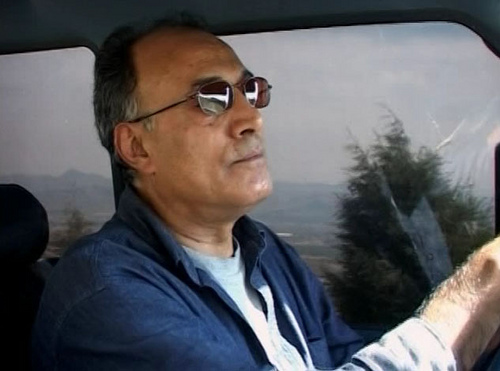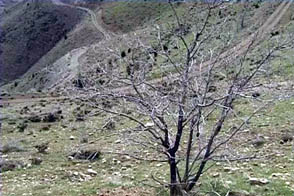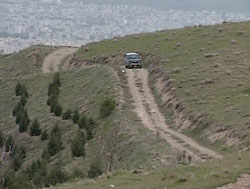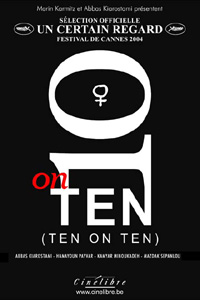From the Chicago Reader (October 29, 2004). — J.R.
10 on Ten
*** (A must-see)
Directed and written by Abbas Kiarostami
With Kiarostami
Abbas Kiarostami’s recent features satisfy few of the usual expectations about narrative films. Yet in 10 on Ten — a documentary about his most recent feature, 10, showing twice this week at the Gene Siskel Film Center–he appears to be slavishly living up to those expectations.
Like 10, 10 on Ten is split into ten chapters, the last nine of which have labels that suggest topics in a master class: “The Camera,” “The Subject,” “The Script,” “The Location,” “The Music,” “The Actor,” “The Accessories,” “The Director,” and “The Last Lesson.” Kiarostami implies that this film — made for the French DVD of 10, released last summer (the U.S. version will be out November 2) — is his attempt to explain the rationale behind his working methods. The film never becomes as far-fetched as Edgar Allan Poe’s 1846 essay “The Philosophy of Composition,” which purports to explain rationally how he made creative decisions in composing “The Raven.” Yet there’s something suspect about Kiarostami’s cookbook-style lucidity — he may be sincere, but he seems to be overestimating the role rationality plays in his decisions.
“Making of” documentaries have been a cottage industry around the world for some time, not simply as DVD “extras” but as promotional tools. In Iran alone, almost any feature of any prominence seems to be accompanied by a documentary that includes an interview with the director and numerous production details. The ways 10 on Ten differs from most of these is that Kiarostami made it himself, he’s the only one appearing in it, and the running time, 87 minutes, is only two minutes shorter than the film it’s about. In other respects he’s offering the usual goods — a careful, step-by-step account of how he conceived and made 10, using clips from it (as well as from Taste of Cherry and ABC Africa) and even an extended outtake.
Most of the arguments offered by 10 on Ten will be familiar to viewers who’ve followed Kiarostami’s career closely; those who remain puzzled by his methods might find it extremely helpful. But whatever one’s take on his work, the apparently simple manner of address here can be deceptive. Even the title is the reverse of what one might expect, given that the original film’s title is usually written as 10, not Ten. And for a director who tends to distrust verbal explanations, he’s made this apologia so verbose — an almost nonstop monologue he delivers while driving his car — that the sometimes awkward English translation consists of a voice-over instead of subtitles.
The first story Kiarostami tells is why he chose to shoot ABC Africa and 10 on digital video. He starts out by remarking that some viewers of 10 were disappointed not to see the landscapes associated with his earlier work, so for 10 on Ten he opted to return to the roads and hills of northern Tehran where he shot Taste of Cherry. He also explains that video footage was used in the final sequence of Taste of Cherry because a lab accidentally ruined the 35-millimeter footage he’d originally intended to use. He substituted video footage that had been shot for a “making of” documentary directed by his son Bahman, though in 10 on Ten he neglects to credit Bahman for it.
Kiarostami goes on to say that he used DV in Uganda as preparatory “travel notes” for ABC Africa, then decided to stick with that footage when he realized that it caught his documentary subjects being more natural and spontaneous than they would have been in front of cumbersome film equipment. This led him to choose DV when shooting 10, and we eventually learn in the chapter on location that he decided to use only two DV cameras mounted on the dashboard of a single car because he was convinced that the film’s structure was more important than either its subject or its “story.”
While planning 10 Kiarostami announced that he would shoot only on DV in the future, then made a DV film called Five that’s virtually the opposite of 10: five documentary studies of patches of the Caspian Sea coastline that have no dialogue at all and concentrate on waves, driftwood, birds, dogs, and insects. The last, longest, and richest sequence — showing the surface of a pond lit by what seems to be moonlight and then spattered with rain — is especially impressive, juxtaposing a maximum of sound effects with a minimum of visual material to create a stunning audiovisual weave. I first saw Five as a museum installation about a year ago in Italy, where I heard Kiarostami ironically and somewhat sheepishly admit that he was planning to shoot his next feature in 35-millimeter — a reminder that his more extreme pronouncements have to be taken with a grain of salt. After winning a prize in Venice for The Wind Will Carry Us in 2000, he announced that he had enough awards and would never place another film in competition at a festival; in 2002 he offered 10 to be considered for competition at Cannes.
In 10 on Ten Kiarostami periodically cuts away from himself inside his car to long shots of the car snaking its way through a hilly landscape — a pattern recognizable from many of his 90s features, including Life and Nothing More…, Through the Olive Trees, Taste of Cherry, and The Wind Will Carry Us. This raises the question of whether this footage is new and whether it was shot on DV. At times it appears to have been shot on film, and it sometimes looks like clips or outtakes from Taste of Cherry.
Kiarostami may be violating more of his own rules. He speaks at length about the virtues of not scripting most of his dialogue, but his discourse here, if not scripted, appears to have been worked out largely in advance. He maintains that his first ideas for films usually take up half a page, then develop into three pages. And he says that now that he no longer has to submit a script to either his French producer or the Ministry of Culture and Islamic Guidance — both aware that he can’t be faithful to what he writes anyway — he finds that when he writes a “full and accurate” script he no longer wants to make the film, so he usually hands the script to a colleague to direct. He doesn’t explain why he no longer has to submit a script to the ministry, though surely it’s relevant that few if any of his recent features have been shown in Iran.
Since 10 on Ten has the kind of neat and orderly arrangement associated with a relatively “full and accurate” script, one may wonder why Kiarostami opted to direct it himself — unlike, say, The White Balloon, The Willow and the Wind, and Crimson Gold. I’m glad he did, even if this documentary doesn’t fit his definition of what constitutes his oeuvre.
In 10 on Ten he imitates himself much more mechanically here than he ever does in 10 or Five, as when he takes his DV camera outside his parked car to show us ants moving on the ground, a ploy borrowed from The Wind Will Carry Us. He also tends to position himself against Hollywood — understandable even when he suggests that Hollywood may create more serious problems in the world than the American military — but at times he almost implies that there are only two way of making films, Hollywood’s and his own.
Still, his aesthetic of austerity is eye-opening, and this film explores it more fully as a position — if not as a practice — than anything else in his work. Whether he’s explaining why commissioning music for a film feels like submitting to an arranged marriage or defying a critic who declared that the dialogue in 10 is “everything” by eliminating first the dialogue and then the image from a scene, he’s rarely rubbing shoulders with the obvious.
The main reason Kiarostami gives for having eliminated a sequence in 10 that showed a young woman passenger singing is that it unbalanced the rest of the film because it was too strong. But when I saw that deleted footage in this film I couldn’t agree. Nevertheless, his subjective and not necessarily rational positions redeem 10 on Ten from its awkward position as a Kiarostami “study guide.” Whether he likes it or not, it’s another piece of his work, warts and all.








